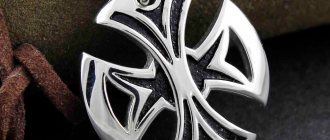What is the power of Buddhist amulets?
To replace the angel symbols, which are popular in all countries of the world, Siddhis appeared in Buddhist culture. These are mystical creatures that became popular thanks to Indian mythology. They possessed enormous magical power, which is why they were used by people to protect themselves from dark forces.
In ancient times, thinkers from India who practiced yoga were called Siddhas. It was believed that they were able to penetrate into the inner world of a person. Recently, siddhis have been called the hidden capabilities that every person has. You can only know them if you study the Buddha and understand your inner world.
Now the symbol of Siddhi has great significance for Hindus. With the help of such a talisman, you can learn the secrets of the creation of the world, understand your own capabilities and develop intuition. These are ordinary ethnic amulets that are common in all countries of the world, but they have their own religious characteristics and specifics, which are not similar to other talismans.
8 Tibetan characters
Tibet - known as the "Roof of the World"
- a wonderful place, rich in tradition, art and symbolism. Tibetan symbols are heavily influenced by Buddhism, so they all have religious symbolism and represent abstract ideas that show the scene in their view of the world.
Eight Tibetan Symbols and Motifs
There are eight main symbols and motifs that have their own special significance for Tibetan Buddhist beliefs. In the land of the Dalai Lama, these symbols can be seen carved and painted in many places. They have their roots in Buddhist teachings and are the main pillars of Buddhist philosophy . Symbols speak much more than a thousand words . Words can be forgotten, but symbols are imprinted in the mind.
Let's look at the most famous Buddhist symbols, also known as Ashtamangala, and the importance of each of them.
Umbrella – Chhatra ( Umbrella )
The umbrella is a Tibetan Buddhist symbol of wisdom and spiritual strength. It symbolizes respect for Buddha. It represents the cool shadow that can be found in the teachings of the Buddha and which serves as protection from suffering and defilement.
Dharmachakra (wheel)
The Dharmachakra or eight spoken words of righteousness symbolize the teachings of the Buddha. The Tibetans call this symbol “choskyi” “khor” or the wheel of transformation.
This is a symbol of the change in human nature brought about by the teachings of the Buddha. The eight spokes represent the eightfold path, the center of the wheel represents the core of the Buddha's teachings, and the spokes represent wisdom. The wheel also represents the cycle of birth and death.
Dhvaya (win)
Victory or Dhvaja is a symbol of victory over the demons of the mind - passion, lust, death and emotional defilement on the path to enlightenment. This symbol represents the victory over ignorance, which the Buddha achieves through his repentance. Thus, victory is the main symbol and motif indicating the Buddha's enlightenment.
Shankha (shell)
The sacred sheath or sankha represents the glory of the Buddha's philosophy, which spreads in various ways like the deep sound of the sheath. It is used in Tibetan Buddhist ceremonies and is a presentation of the Buddha's truth offered to the world.
Lotus flowers
The lotus represents the symbol of human spirituality, following the teachings of Buddha. Just as a lotus takes root in the earth and then rises above it, man rises from the mud of materialism to achieve enlightenment based on the teachings of the Buddha. Red Lotus is a symbol of Tibetan love, compassion and purity. White Lotus is a Tibetan symbol of peace and spiritual enlightenment.
Srivasta (Endless Knot)
Srivasta is one of the most intriguing symbols. The symbol is a trap that has a beginning and an ending point and represents the infinite wisdom of the Buddha, as well as the oath of life and karma through which all our destinies are intertwined. As a symbol of the fact that everything is connected to everything else in this universe, it is a symbol of Tibetan harmony.
Suvarnamaty (Goldfish)
The Goldfish is represented by a pair - one against the other. Pisces represents joy and fertility, as well as abundance. They present the philosophy that a person who follows the teachings of the Buddha cannot drown in the ocean of suffering and swims freely like a fish. The fish is also a symbol of the Buddha's eyes, and he constantly watches over his disciples.
Kalasha (Sacred Vase)
The sacred vase is a symbol of inexhaustible wealth, which is a Buddhist teaching. It represents spiritual abundance, prosperity, wealth and long life.
These are some of the main symbols and motifs associated with Tibetan Buddhism that adorn various structures throughout Tibet. Each symbol has its own meaning and energy. Activate the symbol in your home or work place and let the symbols bring joy and prosperity.
For those who are ready to delve into the essence of life and reveal themselves from the best side - we are waiting!
Elena Kovalenko – founder
Discover new possibilities for your personality. Take advantage of your opportunities!
Light, peace and goodness!
Subscribe to us on social networks!
What are the symbols?
All Buddhist amulets contain sacred knowledge of traditions common in Asian countries. Not only ordinary amulets, which are worn in the form of jewelry, are of great importance. Even the designs that are applied to clothes have meaning.
Talisman with a hieroglyph meaning the syllable Om
There are several types of protective amulets in Buddhist culture.
- Buddha. Statues in the house, images in paintings or clothing, as a symbol on jewelry. This Buddhist amulet is used to develop faith in a person and bring happiness to the home. The Buddha symbol brings peace not only to its owner, but also to everyone around him. Its energy is so strong that you can be charged with it just by looking at this sign, so they try not to hide it, but to put it on public display so that more people can feel the full power.
- Symbolism of amulets. They are presented in the form of one of 8 iconic images. In India, it is customary not only to put such symbols on religious amulets, but also on souvenirs or dishes.
- Mandalas are considered the best option for a person from Russia. Such talismans are marked with the image of the Om symbol, which symbolizes the birth of the world and the entire Universe. If you look closely at this Buddhist amulet, it depicts 3 curved lines, a semicircle and a dot.
- Souvenir talismans. They are often bought by tourists in India to give to loved ones upon arrival home. Making such souvenirs is possible from any materials (clay, plastic, metal, wood or ceramics). If you have money, you can buy souvenir Buddhist amulets made from expensive raw materials - gold or silver. They carry more positive energy than all the others.
There is another version of the Buddhist talisman, which is presented in the form of a rosary. The difference between this talisman and the others is that it is not aimed at protecting a person from negativity.
It can help you concentrate on important things and develop a sense of calm and inner balance. The use of Buddhist rosaries is the same as in the case of Slavic or Orthodox amulets.
You need to carry them in your hand and move similar objects strung on a cord. They can be made from plates, beads or knots.
Rules for choosing a personal Buddhist talisman
For an item to become your reliable assistant, it must be charged
In order for the selected item to become your reliable assistant, it must be properly charged. Special rituals are performed and prayers are read over this symbol. Remember that if you purchase a souvenir in a retail store, it will not have protective functions. Monks do not have the right to sell amulets. They can only charge a rental fee for using the artifact.
When choosing a Buddhist amulet, it is best to consult with the temple servants. The image itself, as well as the material from which the amulet is made, is of no small importance. An amulet made of paper or wood will easily give off its positive energy, will create comfort, and is suitable for home use. Wooden amulets are considered more effective. You need to choose a metal carefully, since a certain planet of the solar system is the patron of each metal.
It is not recommended to purchase several types of Buddhist amulets at once, especially if they have different energies and have different purposes. It is important to concentrate on your most important desire, for example, in order to recover from a disease, you need to select several symbols that are designed to improve health.
By carefully choosing a Buddhist amulet and taking it seriously, you can achieve success in the necessary area of life. Magic objects help individuals seeking self-development and self-improvement. Their energy should not be directed towards worsening the well-being of others.
Talismans with mantras
Among the most popular talismans, diamond protection should be highlighted. It is presented in paper form with black and red patterns. With the help of such a powerful Buddhist amulet, you can not only save your body from troubles, but also get rid of bad thoughts.
To produce a monk's amulet, a paper sheet is used, onto which images are applied using a fur brush. It symbolizes the protection of thoughts and consciousness from the penetration of black magic.
The cloth mantra is a symbol represented by blue cloth on which a pattern is painted with white paint. It protects its owner from the evil eye and damage.
There is a talisman that protects a person from karmic debts. It is made of a white paper sheet on which a mantra written in red is applied. It is called Amitabha after one of the wisdom Buddhas. When you stop wearing it, get rid of it immediately. You can't keep her in the house. Amitabha must be placed in a special box and burned. Only then can you be sure that karmic debts will not overtake you.
Doors are a talisman that allows a person to achieve harmony with himself. With its help you can enlighten yourself and gain the wisdom of your ancestors. It is made of fabric onto which a special spell is applied with black paint, helping the owner to escape from all external evil.
Statue of Buddha Amitabha, after whom the amulet in the form of a paper sheet with a mantra is named
How to make
Buddhists attach special importance to the making of amulets. Their creation is a secret, carefully kept since ancient times. The most popular of them are sunkhors, which are a magic circle - a special diagram in which several circles with different symbols are concentrated.
In general, amulets and amulets can have very different forms and contents - it all depends on the purpose for which they are created. They are also made from various materials. It can be metal, stone, wood, clay, paper and even plastic. The most effective in their action are talismans made of precious metals, which are charged using special rituals performed by Buddhist lamas or monks.
Especially for you: Talisman hand of Fatima, meaning
In Tibet, “diamond amulets” are of particular interest, which are made as follows: take a sheet of paper on which a circle is drawn. A deity is depicted in the center of this circle, and sacred symbols - mantras - are applied around it in multi-colored ink. The leaf is folded and placed in any decoration, worn mainly around the neck. Such amulets are made strictly according to existing canons.
The best male and female mascots
There are symbols that are not universal, i.e. some of them can only be worn by men or only women. Lotus is for women. It symbolizes purity of spirit and external beauty. The owner of a lotus, especially such a tattoo, quickly develops creative potential within herself.
For men, Sak Yant is best. This is a special tattoo on which the sacred commandments of Buddha are written. If a man lives by these commandments, then the talisman will protect him from external evil.
Mandalas
People who are not associated with Eastern beliefs and traditions can use mandalas as protective symbols. These are special patterns and images that are used in a toga to concentrate thoughts and spiritual improvement.
Mandalas are used as protective symbols
The symbol of the model of the Universe are special geometric figures that are used in mandalas. They have a complex structure, they personify the interconnection of all processes in the Universe. Such talismans are used to improve your health and strengthen your energy.
Use of attributes
Talismans from India are common and used in everything related to humans. If you want to protect your home from negativity or enemies, give preference to small figurines and paintings. Common home amulets are flags that are hung in front of the front door. Such a talisman protects the house and its inhabitants from evil spirits.
It is not recommended to install massive talismans in cars so that they do not distract attention. If you want to protect your vehicle from accidents and save your life from danger, invite a lama who will perform a special consecration ceremony. Often special spells or mantras are applied to vehicles. Protective wreaths of sacred flowers are often found.
Body amulets can be in the form of jewelry or small ropes that are hung on the arm. Tattoos are considered the most popular body amulets. Everyone does them: both men and women. They protect a person from troubles more powerful than all other talismans.
You cannot compare Slavic and Buddhist talismans, because they have completely different meanings. Buddhism is a practice that helps a person develop harmony within himself and understand the world around him in all its subtleties. Before choosing this or that talisman, you must study its meaning and understand whether it suits you or not.
Plant and animal amulets
The lotus represents wisdom, enlightenment, perfection
Adherents of Buddhism have always been kind to representatives of flora and fauna. Among them, many plants are considered sacred and are depicted as protective symbols:
- lotus is a water sign, personifies wisdom, enlightenment, perfection;
- goldfish - a paired talisman that helps prevent disagreements in the family and attracts financial stability;
- elephant - identified with spiritual perfection;
- the tiger is strength and power;
- The cat is the personification of the hearth and protects the family.
Most often, animalistic amulets are applied to the body and made in the form of figurines. They are placed in the house in order to cleanse it of negative influences and attract good luck and prosperity.
The history of the appearance of Buddhist symbols
There is a beautiful legend about how eight auspicious symbols appeared in our world.
According to this legend, on the day Buddha attained enlightenment and higher wisdom under the sacred tree, many gods came to pay their respects and presented him with gifts - eight auspicious symbols.
Brahma presented the deity to the Enlightened One with the Dharmachakra (Wheel of Learning). The heavenly god Sakra gave the White Shell to spread the wisdom of the Buddha to each end of the Universe. The earthly god Stavara handed the Buddha a Precious Vessel full of the drink of eternal life. The remaining gods presented Buddha with a pair of Golden Carps, a Lotus, a Victory Banner and a Good Umbrella.
All these symbols in Buddhism became sacred, demonstrating the close connection of the divine with the human world.
We have selected interesting articles for you:
The most powerful runes to attract unconditional love
20.03.2019
The meaning of the Valkyrie amulet - an ancient symbol of warriors
20.03.2019
Symbols of Buddhism and their meaning
According to one Tibetan legend, when the Divine Sage achieved Perfect Awakening, he was presented with eight symbols called auspicious ones. Now they are very popular both in Tibet itself and in countries where Buddhism came through the northern branch. These signs are very ancient and are present in religions such as Hinduism and Jainism. They can also be found on the walls of Buddhist monasteries, and, of course, in the houses of believers. In this article we will look at eight symbols of Buddhism and reflect on their meaning.
How Buddhists Advise Using Symbols
The uses of Buddhist talismans are varied. Much depends on the type of amulet and the wishes of its owner:
- worn on the body if Tibetan amulets are made in the form of a pendant, bracelet, or other jewelry;
- install near the home altar or in places that are especially significant for the owners;
- hang Buddhist symbols on the outside wall of the house to protect against evil;
- hang amulets inside the home, near the windows;
- install on the car dashboard, on windows to protect against accidents;
- apply sacred Buddhist symbols to the body in the form of a temporary or permanent tattoo;
- set at work to improve material well-being and relationships with colleagues.
It does not matter how and where to place amulets for personal use. The main thing is that they are chosen correctly and made in accordance with the canons.











